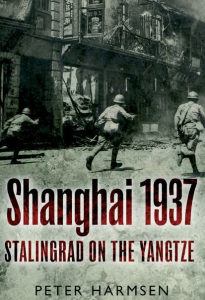2013-08-24 by Robbin Laird
In the recently published history of the Japanese war in China around Shanghai in 1937, Peter Harmsen has provided a rare look in English at this important campaign.
The book is subtitled: Stalingrad on the Yangtze.
The book focuses on a significant urban warfare campaign, in which the Japanese enjoyed air superiority and the use of naval gunfire to support defense and assault operations.
As Harmsen put it:
URBAN WARFARE WAS still new to the world.
Three months of battle in Shanghai in the fall of that year changed all that.
The struggle between China and Japan demonstrated what happens to a major city when it becomes the arena for two vast armies, fielding hundreds of thousands of men and an array of destructive weapons.
Harmsen, Peter (2013-04-15). Shanghai 1937: Stalingrad on the Yangtze (Kindle Locations 58-60). Casemate. Kindle Edition.
Throughout the description of the initial phases of the operation, the author highlights the significance of Japanese air superiority for the defeat of the superior numbers of Chinese ground forces.
And this is a good reminder to 21st century operations as well. In the absence of air superiority winning with ground forces alone is at best an uphill battle.
A couple of quotations from the book provided a clear set of insights into the key role of air superiority, a lesson the Chinese have not forgotten.
It was undeniable that the evolving Japanese air superiority proved a major handicap for the Chinese.
The Chinese commanders soon realized that they had to carry out major troop movements under the cover of darkness.
Japan’s domination of the skies affected everything the Chinese soldiers did and even determined when they could get food.
“We didn’t eat until at night,” said Fang Zhendong, a soldier of the 36th Infantry Division. “That was the only time we could get anything. In the daytime, it was impossible to transport provisions to the frontline.”
Harmsen, Peter (2013-04-15). Shanghai 1937: Stalingrad on the Yangtze (Kindle Locations 1533-1537). Casemate. Kindle Edition.
And as the operation went on, Japanese air superiority became complete with predictable consequences.
In a secret report to Chiang Kai-shek, Falkenhausen described the difficult situation as the Japanese consolidated their material advantage.
“It should be noticed that the enemy’s army and navy act in close coordination. Even though his land-based artillery is still weak, this is compensated for by strong naval artillery and ship-based aircraft,” the German general wrote.
He added that airfields on Chongming Island helped underpin Japan’s now “complete air superiority” in the area, concluding: “As a result, the main operations on our side should be carried out after dark.” 34 The German officer’s words marked both a piece of advice and a statement of established fact.
From late August, most Chinese movement took place after sunset.
Only then could Chinese and Japanese infantry meet on somewhat even terms, without the crushing advantage that air support gave the latter.
Harmsen, Peter (2013-04-15). Shanghai 1937: Stalingrad on the Yangtze (Kindle Locations 1843-1850). Casemate. Kindle Edition.
Latter in the campaign, the situation for the Chinese and their sense of despondency was described in the following words:
The young lieutenant would not fly again during the battle for Shanghai. That day he was grounded, and the same happened the next day, when yet another major Japanese raid took place.
There was no point in taking off to be shot down immediately by a much stronger foe.
The Japanese air superiority in the entire Yangtze Delta region had become unassailable. There was nothing more for Gong to do. He was evacuated west along with other surviving pilots.
On the morning of September 21, they boarded a steamboat heading up the Yangtze. They stood on the deck, watching the Nanjing docks disappear in the mist.
“We felt dejected, thinking about the calamity awaiting the capital,” Gong wrote in his diary.
Harmsen, Peter (2013-04-15). Shanghai 1937: Stalingrad on the Yangtze (Kindle Locations 2560-2565). Casemate. Kindle Edition.
The United States has enjoyed air superiority for a long time; but superiority is not a given, it has to be reborn in every generation of warriors.
Today, superiority is increasingly in question.
It is in question as the evolution of the air capabilities of competitors is enhanced moving forward.
It is in question as the capabilities of defensive systems by competitors are expanded and augmented.
It is challenged in terms of numbers as the size of the USAF is dramatically lower than a decade ago.
And the slow roll out of 5th generation capabilities, both in numbers and in reshaping con-ops, prevails in U.S. acquisition in spite of the evolving global situation.
We certainly do not want to have our ground forces ever facing the situation which confronted China in 1937, but unfortunately the land wars have overshadowed the reality of the need to modernize air power.
http://www.amazon.com/SHANGHAI-1937-Stalingrad-Peter-Harmsen/dp/161200167X
This Fall we are publishing a book with Praeger publishers which looks at how to shape air superiority in the Pacific for the 21st century/
An early look at part of the argument can be found in our new version of Three Dimensional Warriors:


